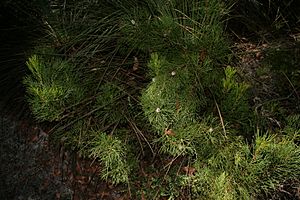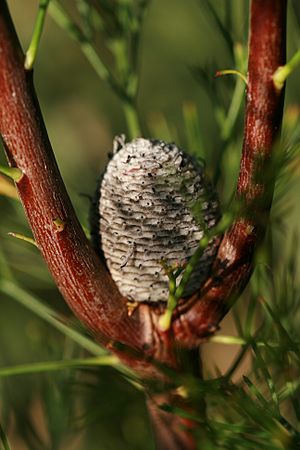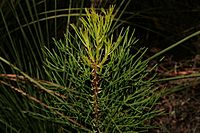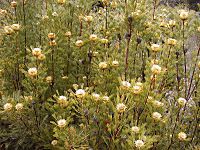Narrow-leaf drumsticks facts for kids
Quick facts for kids Narrow-leaf drumsticks |
|
|---|---|
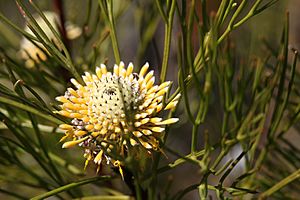 |
|
| Flowers emerging from base of cone | |
| Scientific classification | |
| Genus: |
Isopogon
|
| Species: |
anethifolius
|
| Synonyms | |
|
List
|
|
Isopogon anethifolius, often called narrow-leaf drumsticks, is a type of shrub in the Proteaceae plant family. This plant is special because it is found only in the coastal areas around Sydney in New South Wales, Australia, and a little bit to the west. It grows naturally in woodlands, open forests, and heathlands, especially on sandstone soils.
This upright shrub can grow up to 3 meters (10 feet) tall. It has unique round, narrow leaves that are divided. Its bright yellow flowers appear from September to December and are very noticeable. After the flowers, the plant forms round, grey cones. These cones look like drumsticks, which is how the plant got its common name. The small, hairy seeds are found inside these old flower parts.
Isopogon anethifolius is good at recovering after bushfires. It can grow back from its woody base, called a lignotuber, and also from its seeds. This plant was first described in 1796 by Richard Salisbury and was grown in the United Kingdom that same year. It's one of the easiest plants from the Isopogon group to grow in a garden. It thrives in sunny or partly shaded spots with sandy soil that drains well.
Contents
What it Looks Like
The narrow-leaf drumstick is usually a shrub that grows between 1 and 3 meters (3 to 10 feet) tall. It has an upright habit, meaning it's tall and thin with mostly straight stems. It tends to grow taller in protected areas like woodlands and shorter in more open, windy spots.
Its stems are reddish, and new growth in winter often has reddish and tan colors. The leaves are terete, which means they are round in cross-section, and are less than 1 millimeter (1/25 inch) wide. They branch once or twice along their 16-centimeter (6-inch) length.
Flowers and Cones
The yellow, globe-shaped flowerheads, called inflorescences, appear at the ends of branches. You can see them in spring and early summer, from September to December, though sometimes at other times too. These flowerheads can be up to 4 centimeters (1.6 inches) across.
The individual flowers grow out of a central woody globe in a spiral pattern. Each flower is about 1.2 centimeters (0.5 inches) long. They are straight and have no stalks, growing from a small scale on the globe. Each flower has a tube-like part called the perianth, which covers the plant's reproductive parts. The perianth splits into four parts, showing a thin, delicate style with the stigma at its tip. At the ends of the four perianth parts are the male pollen-producing parts called anthers. The flowers open in a spiral, starting from the outside of the flowerhead and moving inwards.
After the flowers fall away, egg-shaped grey cones appear. These cones are up to 2.5 centimeters (1 inch) wide. The small, hairy seeds are found inside these cones and are about 4 millimeters (0.16 inches) across. Each seed weighs about 4 milligrams.
Unique Leaf Features
The round leaves of Isopogon anethifolius easily help tell it apart from other plants in the Isopogon group, which have flat leaves wider than 1 millimeter. If you look very closely under a microscope, the inner supporting tissue of I. anethifolius has special thick-walled cells called sclereids that are irregularly shaped.
Plant History and Naming
Isopogon anethifolius was one of the plants collected by English botanist Joseph Banks and Swedish naturalist Daniel Solander. They found it on May 5, 1770, at Botany Bay during James Cook's first voyage. A drawing by Scottish artist Sydney Parkinson was later used for a painting by James Britten in 1905.
How it Got its Name
English botanist Richard Salisbury first described this plant in 1796, calling it Protea anethifolia. He found his sample in Port Jackson (Sydney). The name anethifolius comes from two Latin words: anethum, meaning "dill," and folium, meaning "leaf." This is because its leaves look similar to the herb dill.
The common name "drumsticks" comes from the round cones that form on plants in the Isopogon group.
In 1809, the plant got its current name, Isopogon anethifolius. This happened when English plantsman Joseph Knight wrote about it in his book. Another botanist, Robert Brown, also wrote about the Isopogon group, but Knight's book came out first.
Over time, some other botanists described similar plants, but later, these were found to be the same as Isopogon anethifolius. For example, French naturalist Michel Gandoger described four plants in 1919 that he thought were different, but they were all later identified as I. anethifolius.
Like all plants in the Isopogon group, I. anethifolius has 13 haploid chromosomes.
Where it Grows and What it Needs
Isopogon anethifolius is only found in New South Wales, Australia. It grows in the Sydney Basin area and nearby regions, stretching from Braidwood north to Mount Coricudgy in Wollemi National Park. These areas usually get between 900 and 1600 millimeters (35–60 inches) of rain each year.
You can find this plant from sea level up to 1200 meters (4000 feet) high. It prefers sandstone soils and grows in heathland and dry sclerophyll woodland. It often grows alongside trees like scribbly gums (Eucalyptus haemastoma and E. sclerophylla) and silvertop ash (E. sieberi). In open forests, it might be found with soft geebung (Persoonia mollis), and in heathlands, with plants like heath banksia (Banksia ericifolia) and dwarf she-oak (Allocasuarina nana).
Life Cycle and Threats
Isopogon anethifolius has a special way of surviving bushfires. It can grow back from its woody base, called a lignotuber. It is also serotinous, meaning its seeds are stored on the plant in the canopy and are released after a fire. These seeds then fall to the ground or are carried a short distance by the wind.
Plants that resprout from their woody base can flower again in about two and a half years. New plants grown from seeds take a bit longer, around three and a half years, to flower.
Sometimes, a fungus called Vizella can cause spots on the leaves. Also, small insects called weevils might damage the flower buds.
Growing this Plant
Isopogon anethifolius was first grown in gardens in the United Kingdom in 1796. It's known as one of the easiest Isopogon species to grow, along with Isopogon dawsonii. Its delicate leaves, red stems, bright yellow flowers in spring, and unique drumstick cones make it a lovely plant for gardens. It can also be used to create a natural screen for privacy because of its dense leaves.
This plant likes acidic soil and needs extra water, but it doesn't like to sit in waterlogged soil. It grows best in a partly shaded spot, but it can also do well in full sun. It can handle cold temperatures down to about -8 degrees Celsius (18 degrees Fahrenheit). Adding fertilizer in spring can help it grow. Young plants might grow long stems that droop, but they respond well to pruning.
You can grow new plants from cuttings or from seeds. Seeds usually germinate (sprout) after 30 to 60 days. However, it can take several years for a plant grown from seed to start flowering. Some other Isopogon species from Western Australia, like I. cuneatus and I. latifolius, have been grafted onto the roots of I. anethifolius. The flowers, cones, and leaves of this plant are also used in the cut-flower industry.


